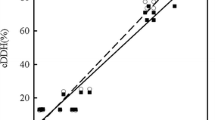Abstract
A new method of membrane-bound DNA × DNA hybridization was devised to accommodate the study of small quantities of DNA obtained from museum specimens for phylogeny reconstruction. Membranebound, single-stranded target genomic DNAs were competitively hybridized with a total genomic DNA probe to form hybrid duplexes required for the DNA dissociation experiments. We compared the thermal elution profiles derived from dissociating duplexes made with probes of whole genomic, single-copy, and repetitive DNA, as well as solution DNA × DNA hybridization using sc tracer. Quantitatively, pairwise indices of genetic distance derived from duplexes made with genomic probes depended entirely on hybridization of repetitive sequences, but a parallel set of experiments using repetitive and sc probes produced qualitatively similar results. The indices of genetic distance generated by the membrane-bound hybrids form an internally consistent, resolved tree which is in agreement with the solution DNA × DNA hybridization trials and traditional views of the phylogeny of the taxa under study.
Similar content being viewed by others
References
Bledsoe AH (1987) Estimation of phylogeny from molecular distance data: the issue of variable rates. Auk 104:563–565
Bledsoe AH, Raikow RJ (1990) A quantitative assessment of congruence between molecular and nonmolecular estimates of phylogeny. J Mol Evol 30:247–259
Bledsoe AH, Sheldon FH (1990) Molecular homology and DNA hybridization. J Mol Evol 30:425–433
Bonner TI, Brenner DJ, Neufeld BR, Britten RJ (1973) Reduction in the rate of DNA reassociation by sequence divergence. J Mol Biol 81:123–135
Britten RJ, Davidson EH (1971) Repetitive and nonrepetitive sequences and a speculation on the origins of evolutionary novelty. Q Rev Biol 46:111–138
Britten RJ, Graham DE, Neufeld BR (1974) Analysis of repeating sequences by reassociation. Methods Enzymol 29:363–418
Brownell E (1983) DNA/DNA hybridization studies of muroid rodents: symmetry and rates of molecular evolution. Evolution 37:1034–1051.
Cavalli-Sforza LL, Edwards AWF (1967) Phylogenetic analysis: Models and estimation procedures. Evolution 21:550–570
Church GM, Gilbert W (1984) Genomic sequencing. Proc Natl Acad Sci USA 81:1991–1995
Doolittle WF (1985) The evolutionary significance of middle repetitive DNAs. In: Cavalier-Smith T (ed) The evolution of genome size. Wiley, New York, pp 443–487
Dover G, Strachan T, Brown SDM (1981) The evolution of genomes in closely-related species. In: Scudder GGE, Reveal JL (eds) Evolution today. Carnegie Mellon University, Pittsburgh, pp 337–349
Eden FC, Hendrick JP, Gottlieb SS (1978) Homology of single-copy and repeated sequences in chicken, duck, Japanese quail, and ostrich DNA. Biochemistry 17:5113–5121
Feinberg AP, Vogelstein B (1984) A technique for radiolabeling DNA restriction endonuclease fragments to high specific activity. Anal Biochem 137:266–267
Felsenstein J (1989) PHYLIP—phylogeny inference package (version 3.2). Cladistics 5:164–166
Higuchi R, Bowman B, Freiberger M, Rider OA, Wilson AC (1984) DNA sequences from the quagga, an extinct member of the horse family. Nature 312:282–284.
Houde P, Braun MJ (1988) Museum collections as a source of DNA for studies of avian phylogeny. Auk 105:773–776
Hoyer BH, McCarthy BJ, Bolton ET (1964) A molecular approach in the systematics of higher organisms. Science 144:959–967
Johnson JL (1981) Genetic characterization. In: Gerhardt P (ed) Manual of methods for general microbiology. American Society of Microbiology, Washington DC, pp 450–472
Kirsch JAW, Ganje RJ, Oleson KG, Hoffman DW, Bledsoe AH (1990) TED, an improved thermal elution devise for the simultaneous hydroxyapatite chromatography of solution DNA/DNA hybrids. Biotechniques 8:505–506
Krajewski C (1989) Comparative DNA reassociation kinetics of cranes. Biochem Genet 27:131–136
Madsen CS, Brooks JE, de Kloet E, de Kloet SR (1994) Sequence conservation of an avian centromeric repeated DNA component. Genome 37:351–355
Olson SL (1985) The fossil record of birds. In: Farner DS, King JR, Parkes KC (eds) Avian biology, vol 8. Academic Press, New York, pp 79–238
Pääbo S (1985) Molecular cloning of ancient Egyptian mummy DNA. Nature 314:644–645
Sarich VM, Schmid CW, Marks J (1989) DNA hybridization as a guide to phylogeny: a critical analysis. Cladistics 5:3–32
Schmid CW, Marks J (1990) DNA hybridization as a guide to phylogeny: chemical and physical limits. J Mol Evol 30:237–246
Schulze DH, Lee CS (1986) DNA sequence comparison among closely related Drosophila species in the mulleri complex. Genetics 113: 287–303
Sheldon FH (1987) Rates of single-copy DNA evolution in herons. Mol Biol Evol 4:56–69
Sheldon FH, Bledsoe AH (1989) Indexes to the reassociation and stability of solution DNA hybrids. J Mol Evol 29:328–343
Sheldon FH, Kinnarney M (1993) The effects of sequence removal on DNA-hybridization estimates of distance, phylogeny, and rates of evolution. Syst Biol 42:3–48
Sheldon FH, Slikas B, Kinnarney M, Gill FB, Zhao E, Silverin B (1992) DNA-DNA hybridization evidence of phylogenetic relationships among major lineages of Parus. Auk 109:173–185
Sibley CG, Ahlquist JE (1981) The phylogeny and relationships of the ratite birds as indicated by DNA-DNA hybridization. In: Scudder GGE, Reveal JL (eds) Evolution today. Carnegie Mellon University, Pittsburgh, pp 301–335
Sibley CG, Ahlquist JE (1990) Phylogeny and classification of birds. Yale University Press, New Haven
Southern E (1975) Detection of specific sequences among DNA fragments separated by gel electrophoresis. J Mol Biol 98:503–517
Springer M, Krajewski C (1989) DNA hybridization in animal taxonomy: a critique from first principles. Q Rev Biol 64:291–318
Wetmore A (1960) A classification of birds of the world. Smithson Misc Coll 139:1–37
Wren HN, Johnson JL, Cochran DG (1989) Evolutionary inferences from a comparison of cockroach nuclear DNA and DNA from their fat-body and egg endosymbionts. Evolution 43:276–281
Author information
Authors and Affiliations
Additional information
Correspondence to: P. Houde
Rights and permissions
About this article
Cite this article
Houde, P., Sheldon, F. & Kreitman, M. A comparison of solution and membrane-bound DNA × DNA hybridization, as used to infer phylogeny. J Mol Evol 40, 678–688 (1995). https://doi.org/10.1007/BF00160517
Received:
Accepted:
Issue Date:
DOI: https://doi.org/10.1007/BF00160517




